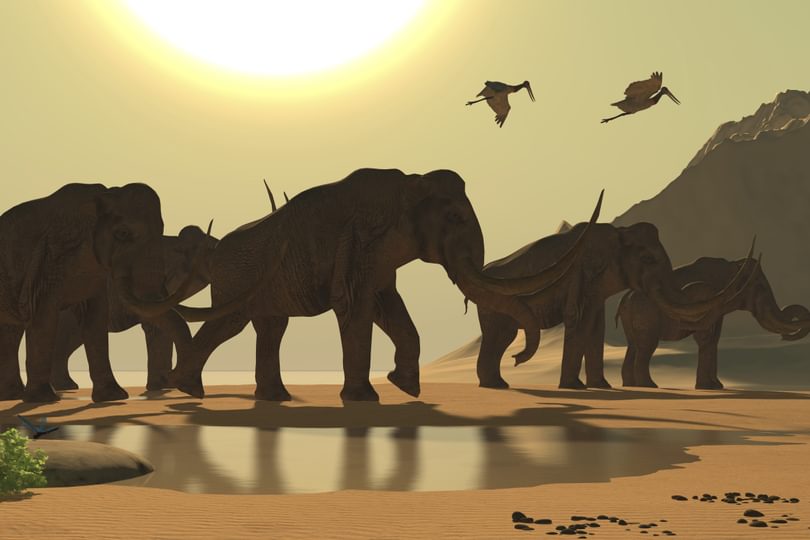
Today sees the online launch of two special features, in Proceedings of the National Academy of Sciences and Ecography, with 22 papers examining how megafauna - large animals - affect ecosystem and Earth System function.
The special features are the result of a major international conference held March 2014, supported by the Oxford Martin School and led by Professor Yadvinder Malhi, Director of the Oxford Centre for Tropical Forests.
The research ranges from the causes of megafauna loss in the Pleistocene age, to its impacts on vegetation and animal communities, and the potential for 'rewilding' as a form of conservation.
One of the papers, co-authored by Professor Malhi, reveals that in the past large land animals, whales, seabirds and fish played a vital role in recycling nutrients from the ocean depths, spreading them far and wide across the globe and taking them deep inland.
However, the paper says massive declines in their populations, coupled with the extinction of most of Earth's large mammals, have disrupted this efficient system of recycling important nutrients, particularly phosphorous. The researchers calculate that the ability of whales and terrestrial megafauna to transport nutrients around the globe has been reduced to just 6 percent of their global capacity before mass extinctions and population declines.
In a blog explaining the implications of the research, Professor Malhi writes: "Collectively, the studies show emphatically the large impact that megafauna have on various aspects of the environment, ranging from vegetation structure and composition, species composition, through fire patterns, soil fertility and nutrient flow in both land and oceans, and even regional and global climate by affecting land surface reflectivity and atmospheric methane concentrations.
"The loss of megafauna cascades through all levels of functioning of ecosystems. Even the apparently wildest contemporary landscapes likely carry the legacies of lost megafauna, and the consequences of contemporary decline of elephants and other megafauna may be felt for centuries or millennia to come.
"This improved understanding of the many ways that megafauna have influenced ecology and biogeochemistry may also help identify hitherto underappreciated and unidentified “ecosystem services” that our planet’s remaining giants provide – or could provide if megafaunas were allowed to recover."
See below for details of the individual papers published in Proceedings of the National Academy of Sciences and Ecography.
- Read Professor Yadvinder Malhi's blog, 'Living in the shadows of lost giants'
- University of Oxford: Declines in whales, fish, seabirds and animals disrupt Earth’s nutrient cycle
Full list of papers:
Causes of Pleistocene megafaunal extinction:
Bartlett, L.J., et al. (2015) Robustness despite uncertainty: regional climate data reveal the dominant role of humans in explaining global extinctions of Late Quaternary megafauna.Ecography
Surovell, T.A., Pelton, S.R., Anderson-Sprecher, R. and Myers, A.D. (2015) A test of Martin's overkill hypothesis using radiocarbon dates on extinct megafauna. Proc Natl Acad Sci USA.
Impacts on vegetation structure:
Bakker, E.S., et al. (2015) Combining paleo-data and modern exclosure experiments to assess the impact of megafauna extinctions on woody vegetation. Proc Natl Acad Sci USA.
Asner, G.P., Vaughn, N., Smit, I.P.J. and Levick, S. (2015) Ecosystem-scale Effects of Megafauna in African Savannas. Ecography.
Villavicencio, N.A., et al. (2015) Combination of humans, climate, and vegetation change triggered Late Quaternary megafauna extinction in the Última Esperanza region, southern Patagonia, Chile. Ecography.
Doughty, C.E., Faurby, S. and Svenning, J-C. (2015) The impact of the megafauna extinctions on savanna woody cover in South America. Ecography.
Barnosky, A.D., et al. (2015) The variable impact of Late-Quaternary megafaunal extinction in causing ecological state shifts in North and South America. Proc Natl Acad Sci USA.
Johnson, C.N., et al. (2015) Geographic variation in the ecological effects of extinction of Australia's Pleistocene megafauna. Ecography.
Terborgh, J. and Davenport, L.C. (2015) Megafaunal influences on tree recruitment in African equatorial forests. Ecography.
Terborgh, J., et al. (2015) The African rainforest: odd man out or megafaunal landscape? African and Amazonian forests compared. Ecography.
Doughty, C. et al. (2015) Megafauna extinction, tree species range reduction, and carbon storage in Amazonian forests. Ecography.
Bakker, E.S., Pagès, J.F., Arthur, R. and Alcoverro, T. (2015) Assessing the role of large herbivores in the structuring and functioning of freshwater and marine angiosperm ecosystems. Ecography.
Trophic cascades and impacts on animal communities:
Estes, J.A., Burdin, A. and Doak, D.F. (2015) Sea otters, kelp forests, and the extinction of Steller sea cow. Proc Natl Acad Sci USA.
Van Valkenburgh, B., Hayward, M.W., Ripple, W.J., Meloro, C. and Roth, V.L. (2015) The impact of large terrestrial carnivores on Pleistocene ecosystems. Proc Natl Acad Sci USA.
Pardi, M.I. and Smith, F.A. (2015) Biotic responses of canids to the terminal Pleistocene megafauna extinction. Ecography.
Smith, F.A., et al. (2015) Unraveling the consequences of the terminal Pleistocene megafauna extinction on mammal community assembly. Ecography.Megafaunal impact on global climate and nutrient cycles
Doughty, C.E., et al. (2015) Global nutrient transport in a world of giants. Proc Natl Acad Sci USA.
Doughty, C.E., et al. (2015) Interdependency of plants and animals in controlling the sodium balance of ecosystems and the impacts of global defaunation. Ecography.
Smith, F.A., et al. (2015) A mammoth amount of methane: exploring the influence of ancient and historic megaherbivore extirpations on the global methane budget. Proc Natl Acad Sci USA.
A wilder Anthropocene:
Svenning, J., et al. (2015) Science for a wilder Anthropocene - synthesis and directions for rewilding research. Proc Natl Acad Sci USA.
Jepson, P. (2015) A rewilding agenda for Europe: creating a network of experimental reserves. Ecography.